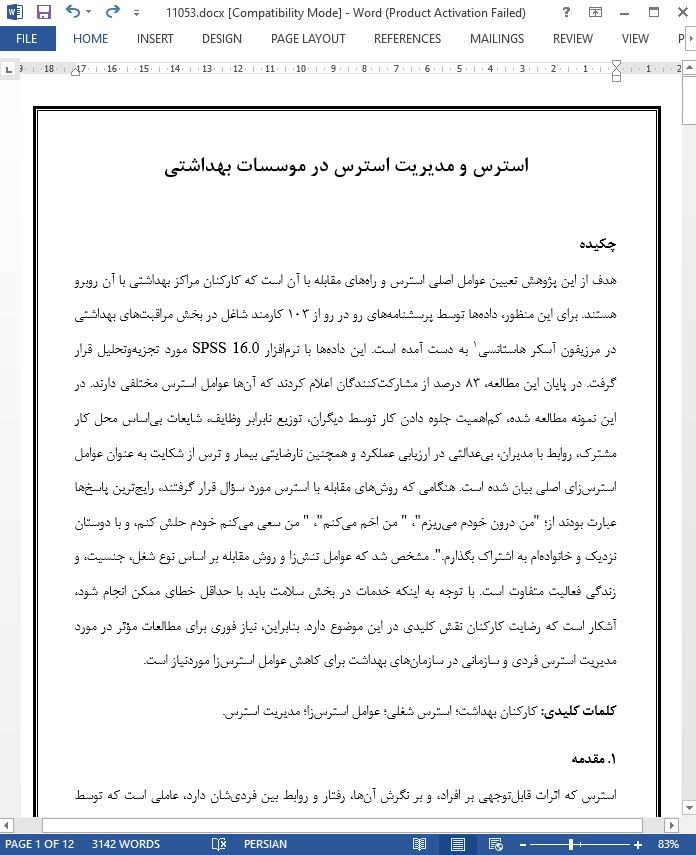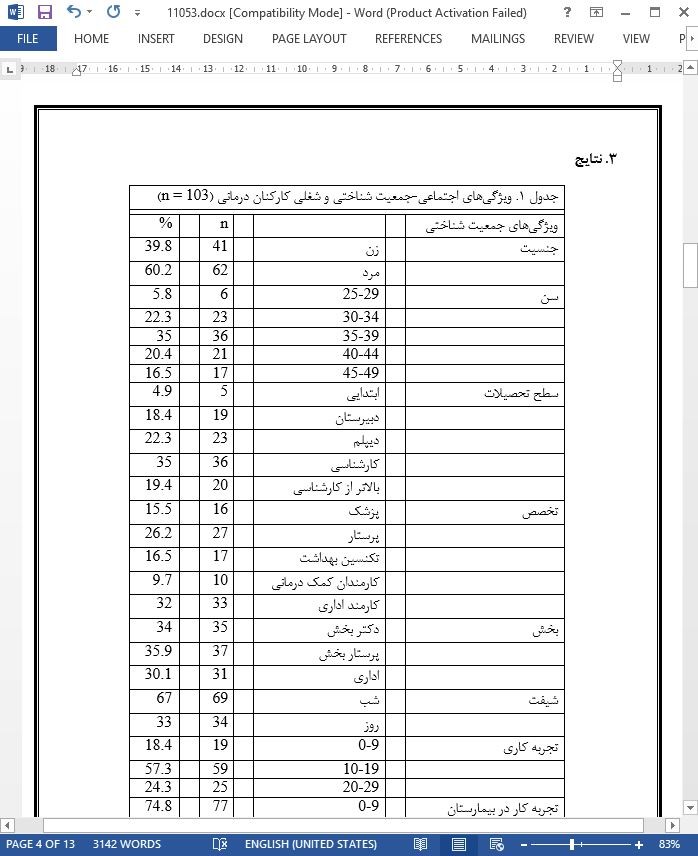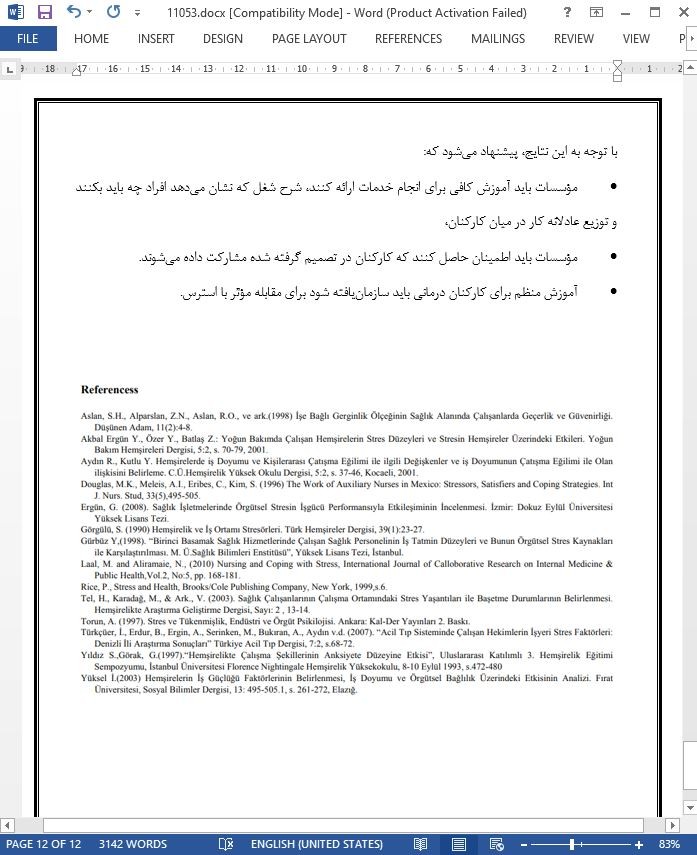
استرس و مدیریت استرس در موسسات بهداشتی
چکیده
هدف از این پژوهش تعیین عوامل اصلی استرس و راههای مقابله با آن است که کارکنان مراکز بهداشتی با آن روبرو هستند. برای این منظور، دادهها توسط پرسشنامههای رو در رو از 103 کارمند شاغل در بخش مراقبتهای بهداشتی در مرزیفون آسکر هاستانسی به دست آمده است. این دادهها با نرمافزار SPSS 16.0 مورد تجزیهوتحلیل قرار گرفت. در پایان این مطالعه، 83 درصد از مشارکتکنندگان اعلام کردند که آنها عوامل استرس مختلفی دارند. در این نمونه مطالعه شده، کماهمیت جلوه دادن کار توسط دیگران، توزیع نابرابر وظایف، شایعات بیاساس محل کار مشترک، روابط با مدیران، بیعدالتی در ارزیابی عملکرد و همچنین نارضایتی بیمار و ترس از شکایت به عنوان عوامل استرسزای اصلی بیان شده است. هنگامی که روشهای مقابله با استرس مورد سؤال قرار گرفتند، رایجترین پاسخها عبارت بودند از؛ "من درون خودم میریزم"، " من اخم میکنم"، " من سعی میکنم خودم حلش کنم، و با دوستان نزدیک و خانوادهام به اشتراک بگذارم.". مشخص شد که عوامل تنشزا و روش مقابله بر اساس نوع شغل، جنسیت، و زندگی فعالیت متفاوت است. با توجه به اینکه خدمات در بخش سلامت باید با حداقل خطای ممکن انجام شود، آشکار است که رضایت کارکنان نقش کلیدی در این موضوع دارد. بنابراین، نیاز فوری برای مطالعات مؤثر در مورد مدیریت استرس فردی و سازمانی در سازمانهای بهداشت برای کاهش عوامل استرسزا موردنیاز است.
1. مقدمه
استرس که اثرات قابلتوجهی بر افراد، و بر نگرش آنها، رفتار و روابط بین فردیشان دارد، عاملی است که توسط عوامل مختلفی تشکیلشده است. برای ایجاد استرس، افراد تحت تأثیر محیطی که در آن زندگی میکنند قرار میگیرند. وضعیت جسمی و روحی افراد، سبک زندگی و وضعیت مالی میزانی که توسط این تغییرات تحت تأثیر قرار میگیرند را تعیین میکند. در جامعه امروز، بیماریهای مرتبط با استرس افزایش روز به روز افزایش میابند، بهطوری که مردم و نهادها با یک مشکل مهم روبرو میشوند (تورون ، 1997 و رایس ، 1999).
4. بحث و پیشنهادات
مشخص شده است که در میان کارکنان بیمارستان نظامی مرزیفون، 83٪ دارای یک منبع استرس هستند. اصلیترین عوامل استرس عبارتاند از: نادیده گرفته شده کار توسط دیگران، توزیع نابرابر وظایف، رواج گسترده شایعات بیاساس در محل کار، ارتباط با مدیریت، بیعدالتی در ارزیابی عملکرد، ترس از نارضایتی و شکایت بیمار است (جدول 2).
Abstract
The purpose of this research was to determine main stress factors that health workers face with and ways of coping with this stress. To this end, data were obtained by face to face questionnaire from 103 health care workers employed in Merzifon Asker Hastanesi. These data were analyzed with SPSS 16.0 package program. At the end of the study, 83% of the participants stated that they have various stress factors. İn the studied sample, disvaluation of work by others, inequitable distribution of tasks, common workplace gossip, relations with managers, injustice in performance evaluation as well as patient dissatisfaction and fear of complaints were found as leading stress factors. When methods for coping with stress were questioned, most common answers were; ‘I repress’, ‘I fret’, ‘I try to solve by myself, and 21will share with my close friends and my family2. İt was found that stress factors and coping methods differ based on occupation, sex, and business life time. Considering that services in health sector should be carried out with the least error possible, its obvious that personnel satisfaction has a key role. Therefore, there is an urgent need for effective studies about individual and corporate stress management are needed in our health corporation for the reduction of stress factors.
1. Introduction
Stress which have significant effects on individuals, and affect their attitudes, behavior and interpersonal relationships, is a case formed by the combination of several factors. For the formation of stress, people need to be affected by the environment they live in. People's physical and emotional status, lifestyle, financial status determines the level of being affected by these changes. In today's society, stress-related diseases increase day by day, so the people and institutions are confronted with an important problem to be faced (Torun, 1997 and Rice, 1999).
4. Discussion and recommendations
It has been determined that among the staff of Merzifon Military Hospital, 83% have a source of stress. The most common stress factors are; work ignored by others, inequitable distribution of tasks, the widespread use of gossip in the workplace, relations with management, injustice in performance evaluation, fear of patient dissatisfaction and complaints (Table 2)
چکیده
1. مقدمه
2. مواد و روشها
3. نتایج
4. بحث و پیشنهادات
Abstract
1. Introduction
2. Materials and methods
3. Results
4. Discussion and recommendations
- اصل مقاله انگلیسی با فرمت ورد (word) با قابلیت ویرایش
- ترجمه فارسی مقاله با فرمت ورد (word) با قابلیت ویرایش، بدون آرم سایت ای ترجمه
- ترجمه فارسی مقاله با فرمت pdf، بدون آرم سایت ای ترجمه



